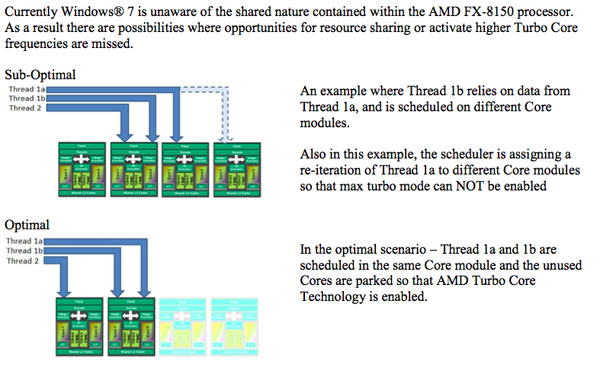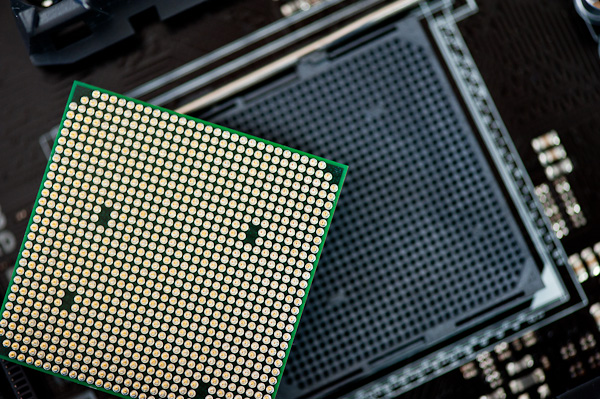The Bulldozer Review: AMD FX-8150 Tested
by Anand Lal Shimpi on October 12, 2011 1:27 AM ESTFinal Words
In many cases, AMD's FX-8150 is able to close the gap between the Phenom II X6 and Intel's Core i5 2500K. Given the right workload, Bulldozer is actually able to hang with Intel's fastest Sandy Bridge parts. We finally have a high-end AMD CPU with power gating as well as a very functional Turbo Core mode. Unfortunately the same complaints we've had about AMD's processors over the past few years still apply here today: in lightly threaded scenarios, Bulldozer simply does not perform. To make matters worse, in some heavily threaded applications the improvement over the previous generation Phenom II X6 simply isn't enough to justify an upgrade for existing AM3+ platform owners. AMD has released a part that is generally more competitive than its predecessor, but not consistently so. AMD also makes you choose between good single or good multithreaded performance, a tradeoff that we honestly shouldn't have to make in the era of power gating and turbo cores.
Bulldozer is an interesting architecture for sure, but I'm not sure it's quite ready for prime time. AMD clearly needed higher clocks to really make Bulldozer shine and for whatever reason it was unable to attain that. With Piledriver due out next year, boasting at least 10-15% performance gains at the core level it seems to me that AMD plans to aggressively address the shortcomings of this architecture. My only concern is whether or not a 15% improvement at the core level will be enough to close some of the gaps we've seen here today. Single threaded performance is my biggest concern, and compared to Sandy Bridge there's a good 40-50% advantage the i5 2500K enjoys over the FX-8150. My hope is that future derivatives of the FX processor (perhaps based on Piledriver) will boast much more aggressive Turbo Core frequencies, which would do wonders at eating into that advantage.

AMD also shared with us that Windows 7 isn't really all that optimized for Bulldozer. Given AMD's unique multi-core module architecture, the OS scheduler needs to know when to place threads on a single module (with shared caches) vs. on separate modules with dedicated caches. Windows 7's scheduler isn't aware of Bulldozer's architecture and as a result sort of places threads wherever it sees fit, regardless of optimal placement. Windows 8 is expected to correct this, however given the short lead time on Bulldozer reviews we weren't able to do much experimenting with Windows 8 performance on the platform. There's also the fact that Windows 8 isn't expected out until the end of next year, at which point we'll likely see an upgraded successor to Bulldozer.

So what do you do if you're buying today? If you have an existing high-end Phenom II system, particularly an X4 970 or above or an X6 of any sort, I honestly don't see much of a reason to upgrade. You're likely better off waiting for the next (and final) iteration of the AM3+ lineup if you want to stick with your current platform. If you're considering buying new, I feel like the 2500K is a better overall part. You get more predictable performance across the board regardless of application type or workload mix, and you do get features like Quick Sync. In many ways, where Bulldozer is a clear win is where AMD has always done well: heavily threaded applications. If you're predominantly running well threaded workloads, Bulldozer will typically give you performance somewhere around or above Intel's 2500K.
I was hoping for Bulldozer to address AMD's weakness rather than continue to just focus on its strengths. I suspect this architecture will do quite well in the server space, but for client computing we may have to wait a bit longer for a more competitive part from AMD. The true culprit for Bulldozer's lackluster single-threaded performance is difficult to track down. The easy answer would seem to be clock speed. We've heard of issues at Global Foundries and perhaps Bulldozer is the latest victim. If AMD's clock targets were 30% higher than Phenom II, it simply didn't make them with the FX-8150. I've heard future derivatives will focus more on increasing IPC indepedent of process technology and clock speed, but if you asked me what was the one limit to success I would say clock speed. As a secondary factor, AMD appeared to make some tradeoffs to maintain a reasonable die size at 32nm. Even then Bulldozer can hardly be considered svelte. I suspect as AMD is able to transition to smaller transistor geometries, it will be able to address some of Bulldozer's physical shortcomings.
The good news is AMD has a very aggressive roadmap ahead of itself; here's hoping it will be able to execute against it. We all need AMD to succeed. We've seen what happens without a strong AMD as a competitor. We get processors that are artificially limited and severe restrictions on overclocking, particularly at the value end of the segment. We're denied choice simply because there's no other alternative. I don't believe Bulldozer is a strong enough alternative to force Intel back into an ultra competitive mode, but we absolutely need it to be that. I have faith that AMD can pull it off, but there's still a lot of progress that needs to be made. AMD can't simply rely on its GPU architecture superiority to sell APUs; it needs to ramp on the x86 side as well—more specifically, AMD needs better single threaded performance. Bulldozer didn't deliver that, and I'm worried that Piledriver alone won't be enough. But if AMD can stick to a yearly cadence and execute well with each iteration, there's hope. It's no longer a question of whether AMD will return to the days of the Athlon 64, it simply must. Otherwise you can kiss choice goodbye.











430 Comments
View All Comments
actionjksn - Thursday, October 13, 2011 - link
AMD Nailpuller? That was some funny shit right there HA HA HASpam not Spam - Wednesday, October 12, 2011 - link
Just skimmed the review; not as awesome as I had hoped for, sadly. That being said, I'm thinking it might well be a nice improvement for the stock, C2D Q6600 in my Dell. I could go Intel, obviously, but... I dunno. I've got an odd fascination with novel things, even if they are rough to begin with. Hell, I've even got a WP7 phone :pwolfman3k5 - Wednesday, October 12, 2011 - link
Then make sure to get a quality power supply and motherboard to go with it. Also, your power bill will increase, but not directly from the Bulldozer CPU, nope, but from all the heat that it will make... you will need to run your air conditioner which is a power hog./* Patiently waiting for AMD's next gen architecture codenamed "Bendover" */
ckryan - Wednesday, October 12, 2011 - link
Is 'ScrewdOver' next on the roadmap after 'Bendover'? I'll have to look in the official AMD leaked slide repository.I still think some intrepid AMD faithful will try BD out just because they're wired that way, and many of the are going to like it. I bet it compares better to Lynnfield than Sandy Bridge... Except Ivy Bridge is closer in the future than SB's launch is in the past. This could be an interesting and relevant product after a few years, but the need is dire now. AMD is going to kill off the Phenom II as fast as possible.
themossie - Wednesday, October 12, 2011 - link
Bendover -> ScrewdOver -> Screwdriver (I'll bring the OJ) -> Piledriver.Courtesy of numerous internal leaks at AMD.
themossie - Wednesday, October 12, 2011 - link
My apologies, didn't realize Piledriver was real.bill4 - Wednesday, October 12, 2011 - link
AKA, the reason all of us who are commenting are reading this review. Gaming performance. And AMD chose not to even compete there. Bunch of monkey overs at AMD CPU engineering?It's now a non starter in the enthusiast market.
I've often though recently that AMD (or any manufacturer really, but AMD as a niche filler would be a more obvious choice given their market position) would do well to try to position itself as the gamers choice, and even design it's CPU's to excel in gaming at the expense of some other things at times. I really suspect this strategy would lead to a sales bonanza. Because really the one area consumers crave high performance is pretty much, only gaming. It's the one reason you actually want a really high performance CPU (provided you dont do some sort of specialized audio/video work), instead of just "good enough" which is fine for general purpose desktoping.
Instead they do the exact opposite with Bulldozer, facepalm. Bulldozer is objectively awful in gaming. Single handedly nobody who posts at any type of gaming or gaming related forum will ever buy one of these. Unbelievable.
Perhaps making it even more stinging is there was some pre-NDA lift supposed reviewer quote floating around at about how "Bulldozer will be the choice for gamers" or something like that. And naturally everybody got excited because, that's all most people care about.
Combine that with the fact it's much bigger and hotter than Intel's, it's almost a unmitigated disaster.
This throws AMD's whole future into question since apparently their future is based on this dog of a chip, and even makes me wonder how long before AMD's engineers corrupt the ATI wing and bring the GPU side to disaster? The ONLY positive thing to come out of it is that at least AMD is promising yearly improvements, key word promising. Even then absolute best case scenario is that they slowly fix this dog in stages, since it's clearly a broken architecture. And that's best case, and assumes they will even meet their schedule.
Anand lays so much of the blame at clockspeed, hinting AMD wanted much more. But even say, 4.3 ghz Bulldozer, would STILL be a dog in all important gaming, so there's little hope.
shompa - Wednesday, October 12, 2011 - link
I have used many AMD systems. Have deployed 1000 of AMD CPU inside Unix workstations at my old work. I cheer for AMD.But.
AMD is going to have a hard time ahead. Selling its fabs to Global foundries was the biggest mistake of them all.
We are in the post PC world. If Tablets are computers: 2012 20% of PCs will use ARM. This is many lost CPU sales for AMD/Intel.
I predict that AMD will be gone within 3 years. Maybe someone buys them? After the settlement with Intel, AMD now can transfer its X86 license to the next buyer. (pending Intels approval)
Maybe Google could buy AMD and build complete computers ?
wolfman3k5 - Wednesday, October 12, 2011 - link
I see two things that might happen to AMD1) They will transform in to a GPU manufacturer completely (and of course they will make those silly APUs)
2) If that damn x86 license is transferable, they could merge with NVidia. Neither of these two companies looks to hot these days, so they might as well work together.
philosofool - Thursday, October 13, 2011 - link
We may be in the "post PC" era, but don't count x86 out. Recent studies indicate there's a corollary to Moore's law that applies to compute power per watt; the study goes back to 1961. This suggests that x86 is only a few years away from running on mobile devices, which is what MS and Intel are betting on. And frankly, it makes sense. Ultimately, I don't want two different things (a mobile device and a PC), I want a PC in my pocket and one on my desk.